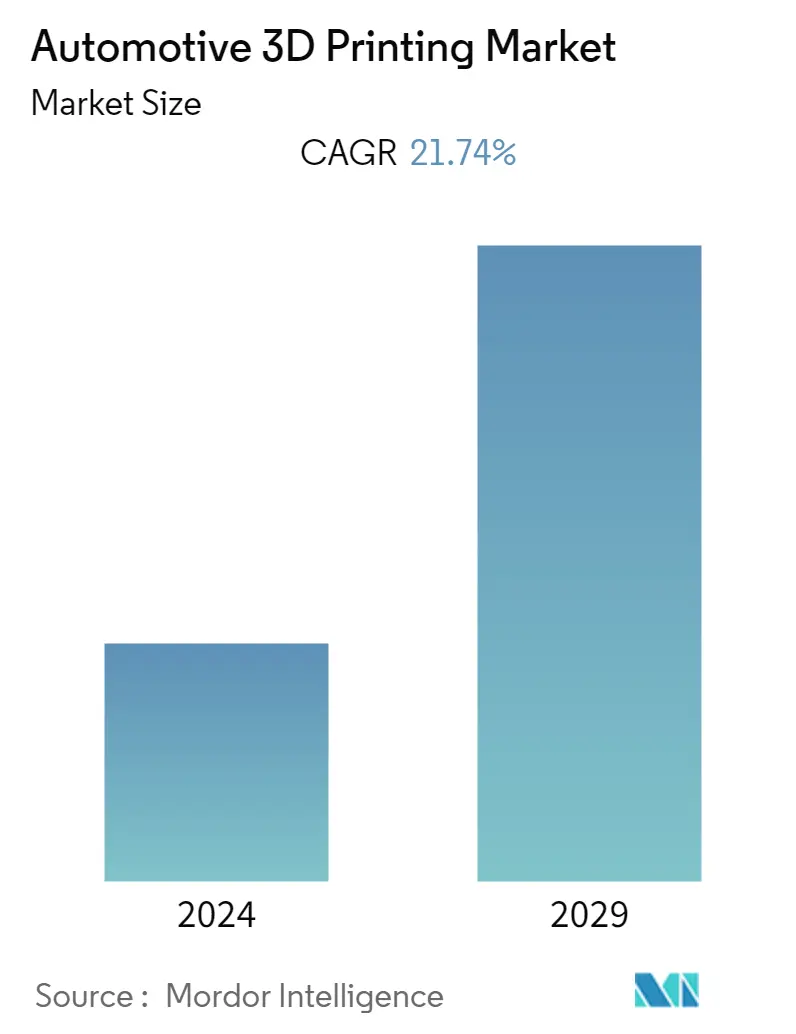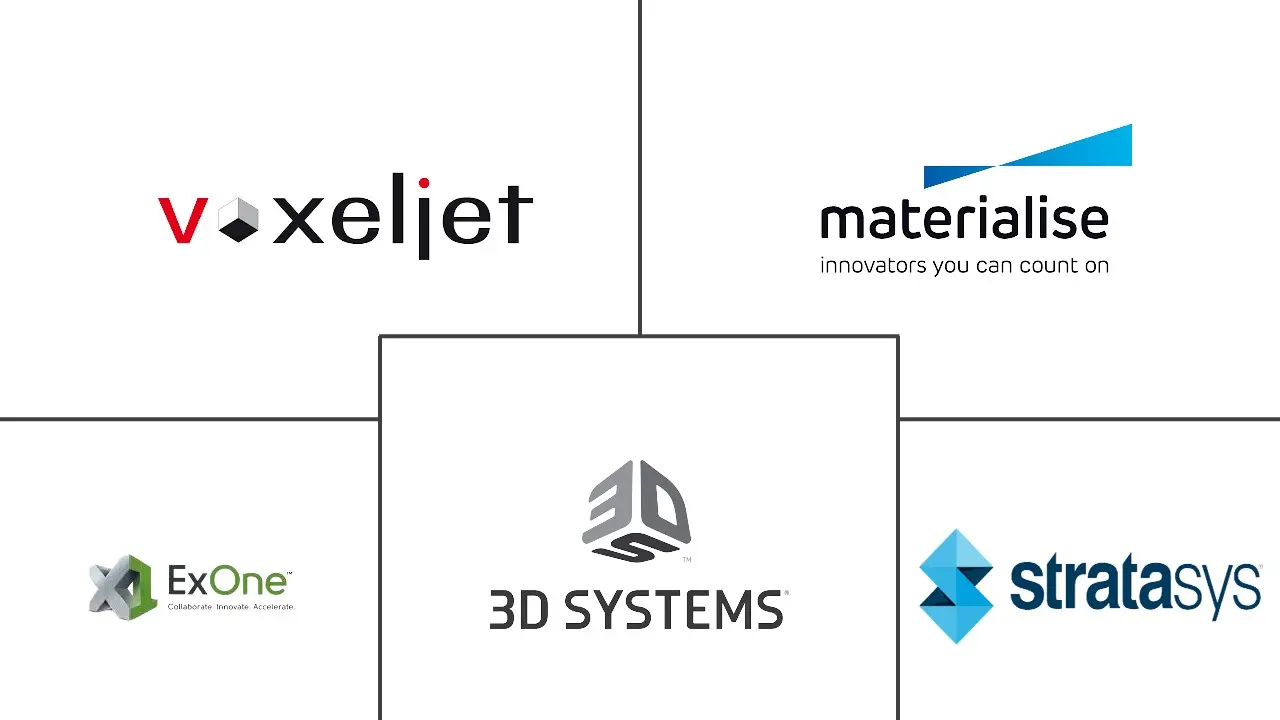Market Size of Automotive 3D Printing Industry

| Study Period | 2020 - 2029 |
| Base Year For Estimation | 2023 |
| CAGR | 21.74 % |
| Fastest Growing Market | Europe |
| Largest Market | North America |
| Market Concentration | Low |
Major Players
*Disclaimer: Major Players sorted in no particular order |
Automotive 3D Printing Market Analysis
The automotive 3D printing market is valued at USD 1.21 billion and is poised to register a CAGR of 21.74% during the forecast period.
The automotive industry experienced unprecedented challenges and uncertainty due to the COVID-19 pandemic. The outbreak had a swift, severe and global impact on the globally integrated supply chains of the automotive industry due to the COVID-19-led lockdowns. Furthermore, the fall in automotive production and lack of labor significantly impacted the market during the first half of 2020. For instance, in 2020, global automotive production dropped to 77.62 million units, a drop of 16% over 2019. The manufacturers are investing in developing new 3D printing systems and expanding their manufacturing capacities. For instance,
- In September 2020, Materialise N.V. invested in Ditto, a 3D printing startup, to advance additive manufacturing technologies for various industries.
Over the long term, the automotive sector trend shortens the turnaround time, reduces material waste, lower manufacturing costs, enhances production rate, shorter overall times for quick automotive parts prototyping, new printing materials for 3D printing, and increased government spending in 3D printing research and development projects will produce considerable growth in the automotive 3D printing market during the forecast period.
Key players are engaging in partnerships to expand their market positions and win key contracts from automotive OEMs. For instance,
- In June 2022, Stratasys was named the official 3D printing partner for Toyota Racing Development. Stratasys' Fortus 450mc, F370, and new composite F370CR 3D printers will be used for production vehicles in the upcoming Toyota GR Cup Series.
Geographically North America was the largest market for automotive 3D printing services and technologies due to the significant presence of automotive 3D printer manufacturers, widespread adoption of 3D printing in the manufacturing industry, and various measures adopted by automotive manufacturers to embrace Industry 4.0 applications.
Thus the factors above are expected to drive significant growth in the automotive 3D printing market.
Automotive 3D Printing Industry Segmentation
3D printing is alternatively known as additive manufacturing, which is the process of creating a three-dimensional object layer by layer with the help of computer-aided design (CAD). In the automotive industry, 3D printing makes customized automotive parts to shorten the turnaround time, reduce material waste, lower manufacturing costs, enhance production rate, and shorter overall times for quick prototyping of automotive parts.
The Automotive 3D Printing Market is segmented by technology type, component type, material type, application type, and geography. Based on technology type, the market is segmented as Selective Laser Sintering (SLS), Stereo Lithography (SLA), Digital Light Processing (DLP), Electronic Beam Melting (EBM), Selective Laser Melting (SLM), and Fused Deposition Modeling (FDM). By component type, the market is segmented as hardware, software, and service. By material type, the market is segregated into metal, polymer, and ceramic. By Application Type, the market is segmented as production and prototyping/R&D. By geography, the market is observed as North America, Europe, Asia-Pacific, and the rest of the world.
The report offers market size and forecasts for Automotive 3D Printing Market in value (USD billion) for all the above segments.
| By Technology Type | |
| Selective Laser Sintering (SLS) | |
| Stereo Lithography (SLA) | |
| Digital Light Processing (DLP) | |
| Electronic Beam Melting (EBM) | |
| Selective Laser Melting (SLM) | |
| Fused Deposition Modeling (FDM) |
| By Component Type | |
| Hardware | |
| Software | |
| Service |
| By Material Type | |
| Metal | |
| Polymer | |
| Ceramic |
| By Application Type | |
| Production | |
| Prototyping/R&D |
| Geography | ||||||
| ||||||
| ||||||
| ||||||
|
Automotive 3D Printing Market Size Summary
The automotive 3D printing market is experiencing significant growth, driven by the need for cost-effective manufacturing solutions and the adoption of advanced technologies. The industry is recovering from the challenges posed by the COVID-19 pandemic, which disrupted supply chains and reduced production. However, manufacturers are now investing in new 3D printing systems and expanding their capacities to enhance production efficiency. The adoption of 3D printing in the automotive sector is facilitated by its ability to shorten turnaround times, reduce material waste, and lower manufacturing costs. Key players in the market are forming strategic partnerships and investing in research and development to leverage these benefits and secure their positions in the industry.
Geographically, North America leads the market due to its early adoption of 3D printing technologies and the presence of major automotive manufacturers. However, Europe and Asia-Pacific are expected to experience rapid growth as the technology becomes more accessible and affordable. The market is characterized by a high level of fragmentation, with numerous startups and established companies like Voxeljet AG, Stratasys Ltd, and Materialise NV actively investing in technological advancements and strategic collaborations. These efforts are aimed at enhancing the material properties of automotive components and streamlining the manufacturing process, thereby driving the expansion of 3D printing in the automotive industry worldwide.
Automotive 3D Printing Market Size - Table of Contents
-
1. MARKET DYNAMICS
-
1.1 Market Drivers
-
1.2 Market Restraints
-
1.3 Industry Attractiveness - Porter's Five Forces Analysis
-
1.3.1 Bargaining Power of Suppliers
-
1.3.2 Bargaining Power of Buyers/Consumers
-
1.3.3 Threat of New Entrants
-
1.3.4 Threat of Substitute Products
-
1.3.5 Intensity of Competitive Rivalry
-
-
-
2. MARKET SEGMENTATION
-
2.1 By Technology Type
-
2.1.1 Selective Laser Sintering (SLS)
-
2.1.2 Stereo Lithography (SLA)
-
2.1.3 Digital Light Processing (DLP)
-
2.1.4 Electronic Beam Melting (EBM)
-
2.1.5 Selective Laser Melting (SLM)
-
2.1.6 Fused Deposition Modeling (FDM)
-
-
2.2 By Component Type
-
2.2.1 Hardware
-
2.2.2 Software
-
2.2.3 Service
-
-
2.3 By Material Type
-
2.3.1 Metal
-
2.3.2 Polymer
-
2.3.3 Ceramic
-
-
2.4 By Application Type
-
2.4.1 Production
-
2.4.2 Prototyping/R&D
-
-
2.5 Geography
-
2.5.1 North America
-
2.5.1.1 United States
-
2.5.1.2 Canada
-
2.5.1.3 Rest of North America
-
-
2.5.2 Europe
-
2.5.2.1 Germany
-
2.5.2.2 United Kingdom
-
2.5.2.3 France
-
2.5.2.4 Rest of Europe
-
-
2.5.3 Asia-Pacific
-
2.5.3.1 China
-
2.5.3.2 Japan
-
2.5.3.3 India
-
2.5.3.4 Rest of Asia-Pacific
-
-
2.5.4 Rest of the World
-
2.5.4.1 Brazil
-
2.5.4.2 Argentina
-
2.5.4.3 Other Countries
-
-
-
Automotive 3D Printing Market Size FAQs
What is the current Automotive 3D Printing Market size?
The Automotive 3D Printing Market is projected to register a CAGR of 21.74% during the forecast period (2024-2029)
Who are the key players in Automotive 3D Printing Market?
Voxeljet AG, Stratasys Ltd, ExOne, 3D Systems and Materialise NV are the major companies operating in the Automotive 3D Printing Market.

